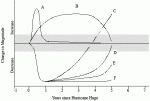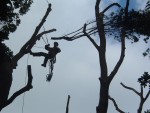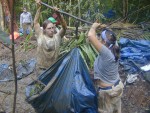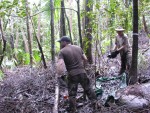Major field study initiated at Luquillo LTER
The Luquillo (LUQ) LTER has begun a major field manipulation at its site in northeastern Puerto Rico to simulate the main impacts of hurricanes on a tropical forest ecosystem. Recent devastation in the U.S. shows how ill-adapted some human systems are to hurricanes, but LUQ studies have revealed how resilient forest systems in Puerto Rico can be (Figure 1). This is not surprising, considering that category 3 or greater hurricanes cross the LUQ site on average every 50-60 years. But how will the forests fare if hurricane intensity or frequency increases, as some climate models suggest? How would that change forest structure, biodiversity, CO2 and trace gas fluxes? Convinced that only a field experiment would reveal the mechanisms of resilience and provide data for reliable predictions, LUQ launched the Canopy Trimming Experiment (CTE) in 2004.
The CTE actually consists of two experiments—one on mechanisms of resilience to hurricanes and one on impacts of more frequent hurricanes. The first experiment focuses on a key process in resilience: post-hurricane decomposition, which is affected by the change in microclimate when the canopy is opened, by the deposition of canopy debris on the forest floor, and by the activity of various organisms that feed on the debris. The treatments are designed to separate and quantify the effects of these factors.
The experiment consists of four treatments, each 30 m x 30 m, spread over 0.52 hectares:
- Canopy trimmed, debris deposited on the forest floor
- Canopy trimmed, debris removed
- Canopy intact, debris added to forest floor
- No trim or debris manipulation
For the trimming, professional arborists cut all branches measuring less than 10 cm in diameter in the treatment sites. The trimmed material from the canopy was sorted, weighed and redistributed across the plots as appropriate. The effects of microorganisms and other groups on decomposition were determined through selective access to debris and appropriate manipulations. Many plant, animal, microbe, environmental, and ecosystem variables also were measured in the year before the treatments began to get a broad and synoptic view of the impacts and responses.
The second experiment will simulate increased hurricane frequency by repeating the treatments every six years.
Luquillo LTER researchers redistribute debris that was trimmed from the canopy in Puerto Rico. The addition of organic matter to certain plots is to mimic the large quantity of detritus distributed onto the forest floor resulting from a hurricane.
The trimming has produced a forest structure and plant responses that nicely resemble those seen after big hurricanes. Resilience is obvious: trimmed trees are resprouting limbs and leaves, understory plants are flowering, previously suppressed saplings are growing, and newly-germinated pioneer trees are colonizing the open sites. This experiment provides an unprecedented, detailed and broad look at hurricane impacts and ecosystem responses and, LUQ researchers hope, a view of future forests.

 Enlarge this image
Enlarge this image


